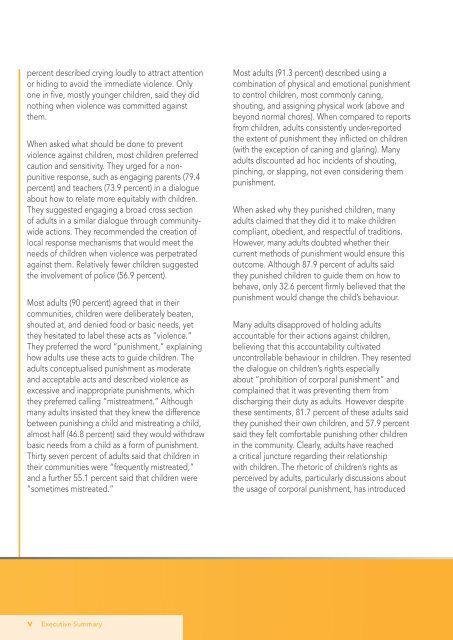Violence against children, the voices of Ugandan ... - Raising Voices
Violence against children, the voices of Ugandan ... - Raising Voices
Violence against children, the voices of Ugandan ... - Raising Voices
Create successful ePaper yourself
Turn your PDF publications into a flip-book with our unique Google optimized e-Paper software.
percent described crying loudly to attract attentionor hiding to avoid <strong>the</strong> immediate violence. Onlyone in five, mostly younger <strong>children</strong>, said <strong>the</strong>y didnothing when violence was committed <strong>against</strong><strong>the</strong>m.When asked what should be done to preventviolence <strong>against</strong> <strong>children</strong>, most <strong>children</strong> preferredcaution and sensitivity. They urged for a nonpunitiveresponse, such as engaging parents (79.4percent) and teachers (73.9 percent) in a dialogueabout how to relate more equitably with <strong>children</strong>.They suggested engaging a broad cross section<strong>of</strong> adults in a similar dialogue through communitywideactions. They recommended <strong>the</strong> creation <strong>of</strong>local response mechanisms that would meet <strong>the</strong>needs <strong>of</strong> <strong>children</strong> when violence was perpetrated<strong>against</strong> <strong>the</strong>m. Relatively fewer <strong>children</strong> suggested<strong>the</strong> involvement <strong>of</strong> police (56.9 percent).Most adults (90 percent) agreed that in <strong>the</strong>ircommunities, <strong>children</strong> were deliberately beaten,shouted at, and denied food or basic needs, yet<strong>the</strong>y hesitated to label <strong>the</strong>se acts as “violence.”They preferred <strong>the</strong> word “punishment,” explaininghow adults use <strong>the</strong>se acts to guide <strong>children</strong>. Theadults conceptualised punishment as moderateand acceptable acts and described violence asexcessive and inappropriate punishments, which<strong>the</strong>y preferred calling “mistreatment.” Althoughmany adults insisted that <strong>the</strong>y knew <strong>the</strong> differencebetween punishing a child and mistreating a child,almost half (46.8 percent) said <strong>the</strong>y would withdrawbasic needs from a child as a form <strong>of</strong> punishment.Thirty seven percent <strong>of</strong> adults said that <strong>children</strong> in<strong>the</strong>ir communities were “frequently mistreated,”and a fur<strong>the</strong>r 55.1 percent said that <strong>children</strong> were“sometimes mistreated.”Most adults (91.3 percent) described using acombination <strong>of</strong> physical and emotional punishmentto control <strong>children</strong>, most commonly caning,shouting, and assigning physical work (above andbeyond normal chores). When compared to reportsfrom <strong>children</strong>, adults consistently under-reported<strong>the</strong> extent <strong>of</strong> punishment <strong>the</strong>y inflicted on <strong>children</strong>(with <strong>the</strong> exception <strong>of</strong> caning and glaring). Manyadults discounted ad hoc incidents <strong>of</strong> shouting,pinching, or slapping, not even considering <strong>the</strong>mpunishment.When asked why <strong>the</strong>y punished <strong>children</strong>, manyadults claimed that <strong>the</strong>y did it to make <strong>children</strong>compliant, obedient, and respectful <strong>of</strong> traditions.However, many adults doubted whe<strong>the</strong>r <strong>the</strong>ircurrent methods <strong>of</strong> punishment would ensure thisoutcome. Although 87.9 percent <strong>of</strong> adults said<strong>the</strong>y punished <strong>children</strong> to guide <strong>the</strong>m on how tobehave, only 32.6 percent firmly believed that <strong>the</strong>punishment would change <strong>the</strong> child’s behaviour.Many adults disapproved <strong>of</strong> holding adultsaccountable for <strong>the</strong>ir actions <strong>against</strong> <strong>children</strong>,believing that this accountability cultivateduncontrollable behaviour in <strong>children</strong>. They resented<strong>the</strong> dialogue on <strong>children</strong>’s rights especiallyabout “prohibition <strong>of</strong> corporal punishment” andcomplained that it was preventing <strong>the</strong>m fromdischarging <strong>the</strong>ir duty as adults. However despite<strong>the</strong>se sentiments, 81.7 percent <strong>of</strong> <strong>the</strong>se adults said<strong>the</strong>y punished <strong>the</strong>ir own <strong>children</strong>, and 57.9 percentsaid <strong>the</strong>y felt comfortable punishing o<strong>the</strong>r <strong>children</strong>in <strong>the</strong> community. Clearly, adults have reacheda critical juncture regarding <strong>the</strong>ir relationshipwith <strong>children</strong>. The rhetoric <strong>of</strong> <strong>children</strong>’s rights asperceived by adults, particularly discussions about<strong>the</strong> usage <strong>of</strong> corporal punishment, has introducedvixixix Part Executive IntroductionOne Research SummaryDesign
















